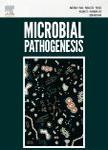版权所有:内蒙古大学图书馆 技术提供:维普资讯• 智图
内蒙古自治区呼和浩特市赛罕区大学西街235号 邮编: 010021

作者机构:Fujian Agr & Forestry Univ State Key Lab Ecol Pest Control Fujian & Taiwan C Fuzhou Fujian Peoples R China Fujian Agr & Forestry Univ Dept Plant Protect Fujian Prov Key Lab Insect Ecol Fuzhou Fujian Peoples R China
出 版 物:《MICROBIAL PATHOGENESIS》 (微生物病原学)
年 卷 期:2018年第124卷第0期
页 面:337-345页
核心收录:
学科分类:0710[理学-生物学] 1001[医学-基础医学(可授医学、理学学位)] 10[医学]
基 金:National Key R&D Program of China [2017YFC1200605] Fujian Science and Technology Special Project [2017NZ0003-1-6]
主 题:Immune response Steinernema carpocapsae Antimicrobial peptides Phenoloxidase Octodonta nipae
摘 要:The Nipa palm hispid, Octodonta nipae (Maulik) is an important invasive pest of palm trees particularly in Southern China. How this beetle interacts with invading pathogens via its immune system remains to be dissected. Steinernema carpocapsae is a pathogenic nematode that attacks a number of insects of economic importance. The present study systematically investigates the cellular immune responses of O. nipae against S. carpocapsae infection using combined immunological, biochemical and transcriptomics approaches. Our data reveal that S. carpocapsae efficiently resists being encapsulated and melanized within the hosts hemolymph and most of the nematodes were observed moving freely in the hemolymph even at 24 h post incubation. Consistently, isolated cuticles from the parasite also withstand encapsulation by the O. nipae hemocytes at all-time points. However, significant encapsulation and melanization of the isolated cuticles were recorded fol- lowing heat treatment of the cuticles. The host s phenoloxidase activity was found to be slightly suppressed due to S. carpocapsae infection. Furthermore, the expression levels of some antimicrobial peptide (AMP) genes were significantly up-regulated in the S. carpocapsae-challenged O. nipae. Taken together, our data suggest that S. carpocapsae modulates and surpasses the O. nipae immune responses and hence can serve as an excellent biological control agent of the pest.